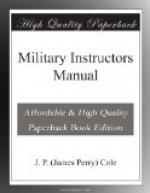TREATMENT OF WOUNDS.—The compress, of the first aid packet will always prove of help.
BLEEDING WOUNDS.—The bandage of the first aid packet will stop all ordinary bleeding; but in aggravated cases the bleeding may be stopped by pressure on the artery, between the wound and the heart. This may be done by hand or by means of the forceps in the medical pouch. The points of compression should be learned and located; in front of the ear just above the socket of the jaw; in the neck in front of the strongly marked muscle reaching from behind the ear to the upper part of the breast bone; in the hollow behind the collar bone; just behind the inner border of the larger muscle of the arm; the femoral artery at the middle of the groin where the artery passes over the bone. Bleeding may also be stopped to some extent by elevating the wounded part. A tourniquet may be improvised by using the compress, running a stick or the bayonet through the band, and taking up the slack by twisting.
POISONED WOUNDS.—For a snakebite make a tight constriction just above the wound; make an incision at the bite and suck out the poison. Do it quickly. If this is impossible, follow the same plan but give a stimulant; repeatedly loosen the constriction and let a little of the poison into the system at a time to be neutralized. In cases of chemical poisoning do not follow the usual method of treating poisoning. Do not make the patient vomit, but give him something fat or albuminous such as raw eggs or milk. This forms mercurial albuminate. Ptomaine poisoning (symptoms are headache, cramps, nausea, high fever and chills, etc.). Drink salt water, vomit and repeat the procedure to clean out the stomach. A purgative should also be taken. Ice cream and milk kept too long are frequent causes of this sort of poisoning, as are dishes kept in the icebox over night.
FAINTING, HEAT EXHAUSTION AND SHOCK are all of the same class; symptoms are the same—weak pulse, paleness and low temperature, tendency to fall to ground. Often follows taking too much water on the march. Treatment should be in nature of stimulant; make patient lie down, get blood to his head, wrap him in blankets, give him hot drinks, etc.
SUNSTROKE.—Symptoms and treatment are different. Patient has a high temperature. Keep his head high and feet low; disrobe him and pour cold water on him; keep him in a cool place until temperature lowers to 101; then remove cold water and temperature will go down itself. Do not apply cold water too long as the temperature may go to sub-normal which is just as dangerous as a temperature abnormally high.
BURNS AND SCALDS.—Air should be shut out; otherwise treat like blister, care being taken not to remove skin. Do not put on anything that will stick and do not try to remove anything that has a tendency to stick; put on linseed oil and water, cotton and a loose bandage.




